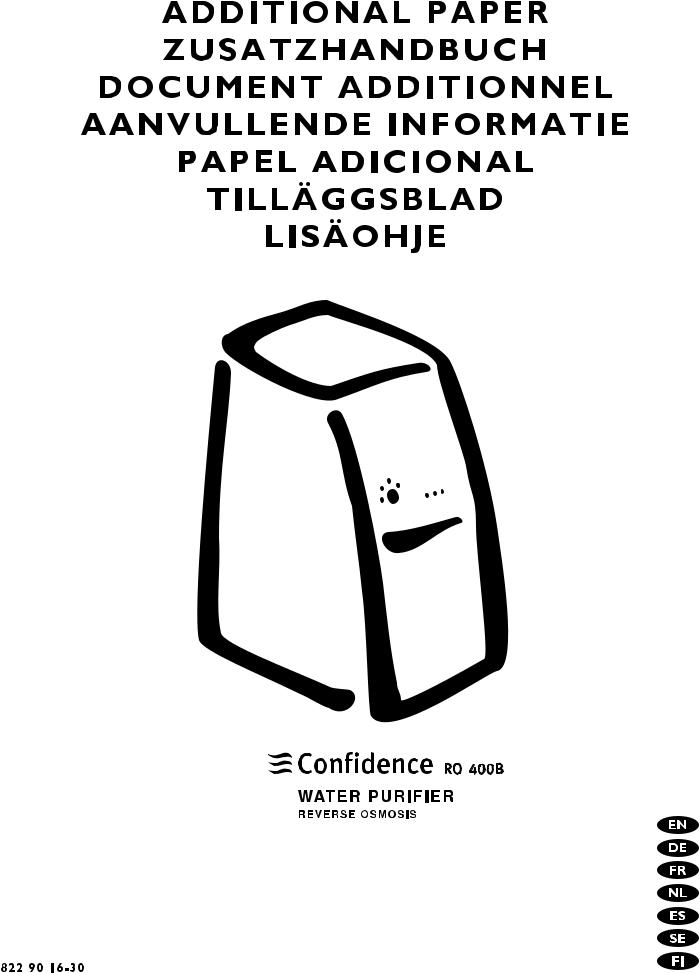AEG RO400B Manual [nl]


Your new water purifier
This manual only brings up the difference between the regular purifier and the brackish model. It is important that you read both manuals carefully.
The English manual starts at page 4.
Dieses Handbuch bezieht sich nur auf die Unterschiede zwischen dem Basismodell und dem Brackwasser-Modell. Es ist wichtig, daß Sie beide Handbücher aufmerksam lesen.
Das Handbuch in Deutsch beginnt ab Seite 5.
Ce manuel précise uniquement la différence entre le modèle de base et le modèle pour eau saumâtre. Il est important de lire attentivement les deux manuels.
Le manuel en français commence page 6.
In deze handleiding wordt het verschil tussen het basismodel en het model voor brak water beschreven. Het is van belang dat u beide handleidingen zorgvuldig doorleest.
De Nederlandse handleiding begint op pagina 7.
Este manual indica la diferencia entre el modelo básico y el modelo de agua salada. Es importante que lea detenidamente ambos manuales.
El manual en Español empieza en la página 8.
Denna manual tar endast upp skillnaden mellan sötvatten modellen och bräckt vatten modellen. Det är därför viktigt att Du läser igenom BÅDA bruksanvisningarna.
Manualens svenska handledning börjar på sidan 9.
Tässä käyttöohjeessa käsitellään ainoastaan makean veden ja murtoveden puhdistamiseen tarkoitettujen laitteiden eroja. Siksi on tärkeää, että luet molemmat käyttöohjeet läpi.
Suomenkieliset ohjeet alkavat sivulta 10.
- 3 -
Safety information
There are some things that are especially important for the brackish model.
•Check that the water you intend to purify meets the requirements specified in “Technical facts”.
•It is very important that the purifier is connected to water and electricity. Brackish water often contains organic materials that will increase the bacteria growth. To prevent this an automatic flush is performed every 12 hour.
•If the purifier is to be disconnected from water and electricity it should be stored as described in “Storage”. Otherwise the bacteria growth will start and the purifier will take on an odour.
•Concerning the installation, the material in all components at the intakeand drain connections must be resistant to corrosion, for example plastic or stainless steel.
•When calibrating the purifier make sure the water temperature is 2-20 °C. If it is higher there may be a risk that the water will taste of salt before low purification level is indicated on the control panel.
Technical facts
Capacity: the values apply to a new membrane and the salt content 600-7500 mg/l.
- Temperature 5 °C |
2,0 (±0.5) litres/minute |
- Temperature 15 °C |
2,5 (±0.5) litres/minute |
- Temperature 25 °C |
3,0 (±0.5) litres/minute |
Water efficiency:
- During operation: |
approx. 60 % |
- Including flushing: |
approx. 40-60 % |
Requirements on feed water to the purifier
- Water temperature |
2 - 30 °C |
- conductivity |
<1300 mS/m |
- /salt |
<7500 mg/l |
- /chloride Cl ¯ |
<4500 mg/l |
Other requirements see ”Technical facts” in the manual for the basic model.
Rejection
Sodium and chloride are not separated in the same extent because of the high salt content.
- Chloride |
> 95 % |
- Sodium |
> 92 % |
More parameters see ”Technical facts” in the manual for the basic model.
Installation to well or sea/lake
Contact your dealer for more information about installing to a well or to a sea or lake.
Suction installation
•This must be carried out with a coarse screen to separate large particles.
•The coarse screen should be easy to clean.
•The coarse screen must be installed vertical position.
•The suction nozzle must be beneath the water surface and unaffected by wind and waves. The suction nozzle must be placed at least 1 m from the bottom.
Hose
The hose must be:
•Placed in a frost proof depth or together with a heating cable.
•Protected from direct sun light, wind, waves and ice.
Extra pre-filter
When the purifier is installed to purify water from a well or sea/lake a pre-filter is required before the purifier.
- 4 -
